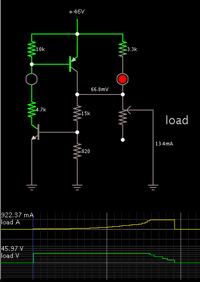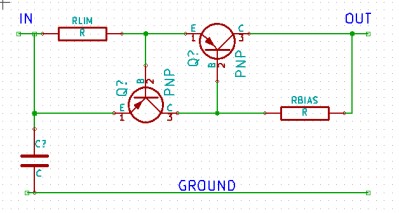boylesg
Advanced Member level 4

- Joined
- Jul 15, 2012
- Messages
- 1,023
- Helped
- 5
- Reputation
- 10
- Reaction score
- 6
- Trophy points
- 1,318
- Location
- Epping, Victoria, Australia
- Activity points
- 11,697
This circuit works really well in that you get a very sharp drop off in output voltage from Q1 at around 1% of 1k pot.....around 10R.
Up until that load the voltage remains very close to 15V before dropping off sharply until Q1 turns off entirely.
I am trying to modify the circuit to take 46V input and have the same characteristics or as close as possible to the 15V version.
What happens is that the output voltage of Q11 starts dropping slowly at around 7% of 1k pot.....so around 70R. As you reduce the pot below 7% the voltage continues to drop more gradually until Q11 turns off completely at around 1.5% or something like that.
I have tried setting all the resistor values such that, with the pot at 100%, the mA in each arm of the circuit are roughly the same as with the 15V version of the circuit and such that the voltage divider gives as close as possible to the same output voltage of around 2.16V. But that does not seem to work. I have also tried reducing the total resistance of the voltage divider so as it increase the base current of Q2 and keep it in saturation, but that doesn't seem to have any effect either.
Can anyone give me some pointers here as to how I might go about reproducing the sharp voltage drop off as occurs with the 15V version of the circuit above.
Up until that load the voltage remains very close to 15V before dropping off sharply until Q1 turns off entirely.
I am trying to modify the circuit to take 46V input and have the same characteristics or as close as possible to the 15V version.
What happens is that the output voltage of Q11 starts dropping slowly at around 7% of 1k pot.....so around 70R. As you reduce the pot below 7% the voltage continues to drop more gradually until Q11 turns off completely at around 1.5% or something like that.
I have tried setting all the resistor values such that, with the pot at 100%, the mA in each arm of the circuit are roughly the same as with the 15V version of the circuit and such that the voltage divider gives as close as possible to the same output voltage of around 2.16V. But that does not seem to work. I have also tried reducing the total resistance of the voltage divider so as it increase the base current of Q2 and keep it in saturation, but that doesn't seem to have any effect either.
Can anyone give me some pointers here as to how I might go about reproducing the sharp voltage drop off as occurs with the 15V version of the circuit above.




